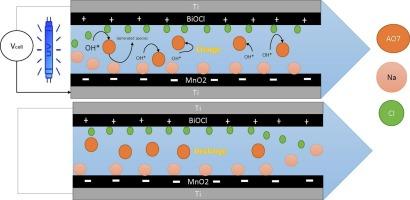评估在含盐废水处理中利用电容去离子和紫外-电氧化混合工艺同时去除盐和染料的效果
IF 9.8
1区 工程技术
Q1 ENGINEERING, CHEMICAL
引用次数: 0
摘要
本研究的目标是通过将电容去离子(CDI)技术与基于紫外线的电化学高级氧化工艺(UV-EAOP)相结合,同时消除盐(NaCl)和染料(C-I 酸性橙 7 或 AO7)。为了优化 MnO2 电极的盐吸附容量(SAC),采用了田口试验设计方法来微调合成参数,包括浴槽温度、电流密度和前驱体浓度。合成了 BiOCl 并将其用作阳极,以提高 AOP 的有效性。为了分析 AOP 和 CDI 组合应用的效果,进行了多次实验。实验结果表明,参数优化改善了 SAC,而紫外线照射则降低了电极的 SAC。此外,还观察到 AO7 可以提高 SAC,同时降低盐吸附率(SAR)。更重要的是,CDI 和 AOP 的联合应用提高了污染物去除效率,改善了 SAC,同时降低了 SAR。最后,色素在 90 分钟后被完全消除,生成的物种可通过气相色谱-质谱(GC-MS)识别。此外,根据生成的物种,还提出了 AO7 降解的可能途径。本文章由计算机程序翻译,如有差异,请以英文原文为准。

Assessment of simultaneous removal of salt and dye by utilizing capacitive deionization and UV-electro oxidation hybrid process in saline wastewater treatment
In this research, the goal was simultaneous elimination of salt (NaCl) and dye (C·I Acid Orange 7 or AO7) through integration of capacitive deionization (CDI) technique with UV-based electrochemical advanced oxidation process (UV-EAOP). To optimize salt adsorption capacity (SAC) of MnO2 electrode, Taguchi's experimental design methodology was employed to fine-tune synthesis parameters, including bath temperature, current density, and precursor concentrations. BiOCl was synthesized and implemented as an anode to bolster AOP's effectiveness. Several experiments were conducted to analyze the effects of applying the combined AOP and CDI. The findings revealed that parameter optimization improved SAC, and the application of UV irradiation decreased electrode's SAC. Furthermore, it was observed that AO7 could enhance SAC while lowering salt adsorption rate (SAR). More importantly, the combined application of CDI and AOP resulted in superior pollutant removal efficiency and improved SAC, despite reduced SAR. Finally, color was entirely eliminated after 90 min, and the generated species were recognized by GC–MS. Additionally, a possible pathway for AO7 degradation was suggested based on the generated species.
求助全文
通过发布文献求助,成功后即可免费获取论文全文。
去求助
来源期刊

Desalination
工程技术-工程:化工
CiteScore
14.60
自引率
20.20%
发文量
619
审稿时长
41 days
期刊介绍:
Desalination is a scholarly journal that focuses on the field of desalination materials, processes, and associated technologies. It encompasses a wide range of disciplines and aims to publish exceptional papers in this area.
The journal invites submissions that explicitly revolve around water desalting and its applications to various sources such as seawater, groundwater, and wastewater. It particularly encourages research on diverse desalination methods including thermal, membrane, sorption, and hybrid processes.
By providing a platform for innovative studies, Desalination aims to advance the understanding and development of desalination technologies, promoting sustainable solutions for water scarcity challenges.
 求助内容:
求助内容: 应助结果提醒方式:
应助结果提醒方式:


